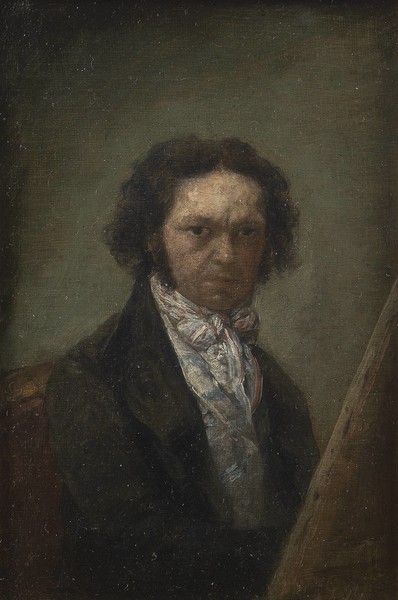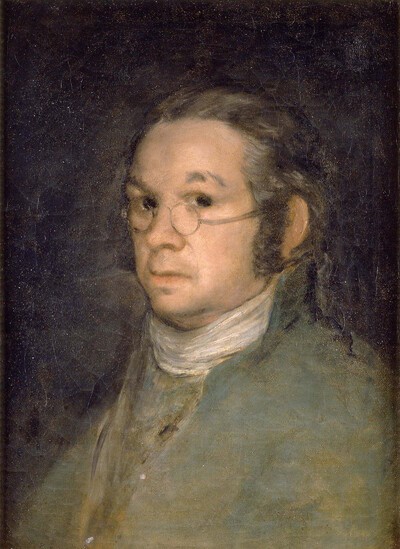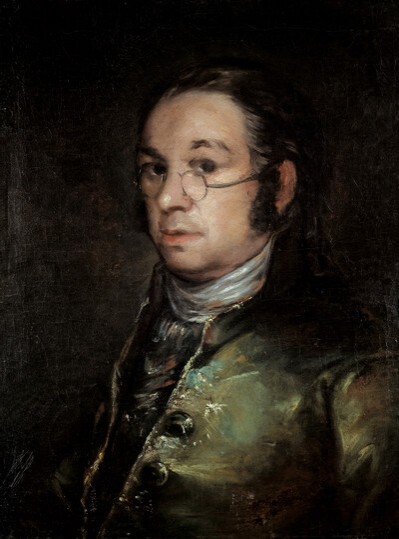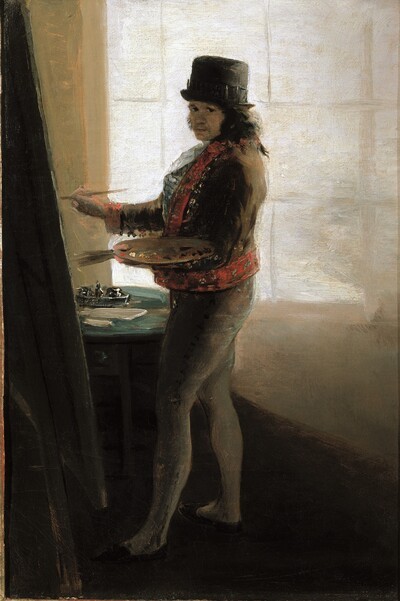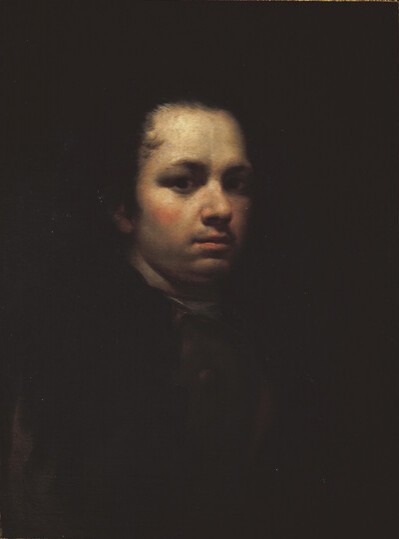- Cronología
- 1796 - 1797
- Ubicación
- The Prado National Museum. Madrid, Madrid, Spain
- Dimensiones
- 18.2 x 12.2 cm
- Técnica y soporte
- Oil on canvas
- Reconocimiento de la autoría de Goya
- Documented work
- Titular
- El Prado National Museum
- Ficha: realización/revisión
- 02 Feb 2010 / 15 Jun 2023
- Inventario
- (P07775)
Goya (lower right-hand corner).
This work belonged to the Duchess of Alba. After her death in 1802, it went to Tomás de Berganza, of Madrid, who left it to his son, Luis de Berganza, also of Madrid. Later it belonged to Carmen Berganza de Martín, Madrid; Pilar Martín Berganza, Madrid; and Antonio Martín. It was sold at E. Peel y Asociados, Madrid, on 31 October 1989 and entered the Gutiérrez de Calderón collection.
It came to form part of the collection of the Prado Museum partially in lieu of taxes and the Villaescusa bequest of 1995.
Goya painted himself as many other artists, including Durero, Rubens and Rembrandt had done before him, and as Picasso would do much later. Fifteen self-portraits by Goya are known to exist, with the artist first painting these works at a very young age.
This particular one was painted when he was around fifty years of age. It shows the top half of the artist as he sits in front of a canvas, ready to start work on a new painting. His eyes stare out at the viewer, and his face reflects the intense concentration that the painter needed to produce his works. The face is gently lit on the forehead, with the cheeks falling somewhat into shadow. His brow is slightly creased, his hair left long, with a centre parting that gives him a pre-Romantic air. He is wearing a dark frock coat and has a scarf tied around his neck, the lighter tones and pink and blue touches of which bring light to the composition.
The background, although neutral, just as in the majority of the painter's portraits, does feature certain light effects.
The brushstrokes are very fast and confident.
Juliet Wilson says of this self-portrait that it is a genuinely emotive image of the painter, exquisitely painted, and revealing at once both the strength and the sensitivity, the innate self-confidence and the dignity of an artist who was able to see and understand all.
-
Goya. El gusto español: antiguos maestrosGalería CaylusMadrid1992cat. 31
-
El Autorretrato en la pintura española. De Goya a Picasso (I parte)Fundación Cultural MapfreMadrid1991consultant editor Wifredo Rincón. From September 26th 1991 to January 8th 1992cat. 7
-
Retratos de Madrid: villa y corteCentro Cultural de la VillaMadrid1992from March 12th to April 26th 1992cat. 41
-
Goya. La década de Los CaprichosMadrid1992organized by Real Academia de Bellas Artes de San Fernando sponsored by Fundación Central Hispano, Madrid, consultant editor Nigel Glendinnig. From October 26th 1992 to January 10th 1993cat. 62
-
Goya. El Capricho y la Invención. Cuadros de gabinete, bocetos y miniaturasMuseo Nacional del PradoMadrid1993from November 18th 1993 to February 15th 1994. Exhibited also at the Royal Academy of Arts, London, March 18th to June 12th 1994 and The Art Institute of Chicago, Chicago, July 16th to October 16th 1994, consultant editors Manuela B. Mena Marqués and Juliet Wilson-Bareaucat. 63
-
Goya. 250 AniversarioMuseo Nacional del PradoMadrid1996consultant editor Juan J. Luna. From March 29th to June 2nd 1996cat. 89
-
Génie et folie en Occident. Une histoire de la mélancolieNeue NationalgalerieBerlin2006from January 28th to April 23th 2006cat. 172
-
Goya e ItaliaMuseo de ZaragozaZaragoza2008organized by the Fundación Goya en Aragóna, consultant editor Joan Sureda Pons. From June 1st to September 15th 2008cat.76
-
Zaragoza2017cat. 84
-
Goya: The PortraitsLondon2015cat. 23
-
Vie et ouvre de Francisco de GoyaParísOffice du livre1970p. 188, cat.665
-
BarcelonaPolígrafa1970vol. I, p. 290, cat. 338
-
El autorretrato en la pintura española. De Goya a PicassoMadridFundación Cultural MAPFRE Vida1991pp. 66 y 67 (il.)
-
La década de los Caprichos. Retratos 1792-1804MadridReal Academia de Bellas Artes de San Fernando1992cat. 62
-
Goya. El capricho y la invención. Cuadros de gabinete, bocetos y miniaturasMadridMuseo del Prado1993pp. 256-257-258 y 259 (il.)
-
Goya. 250 AniversarioMadridMuseo del Prado1996pp. 176 (il.), 366 y 367, cat. 89
-
Goya e Italia, 2 vols.ZaragozaFundación Goya en Aragón y Turner2008vol. I, p. 55 (il.), vol. II, pp. 200 y
-
BilbaoFundación bancaria “la Caixa” y Museo Nacional del Prado2018p. 197
-
LondonNational Gallery Company2015pp. 89-94
